Singleton Hospital Birthing Suites for Hunter New England Health
Described as the best birthing suites in the country and ‘world best’, the Singleton Hospital Birthing Suites are designed with the emotional needs of the mother, care-giver and midwifery staff first.
Client
Location
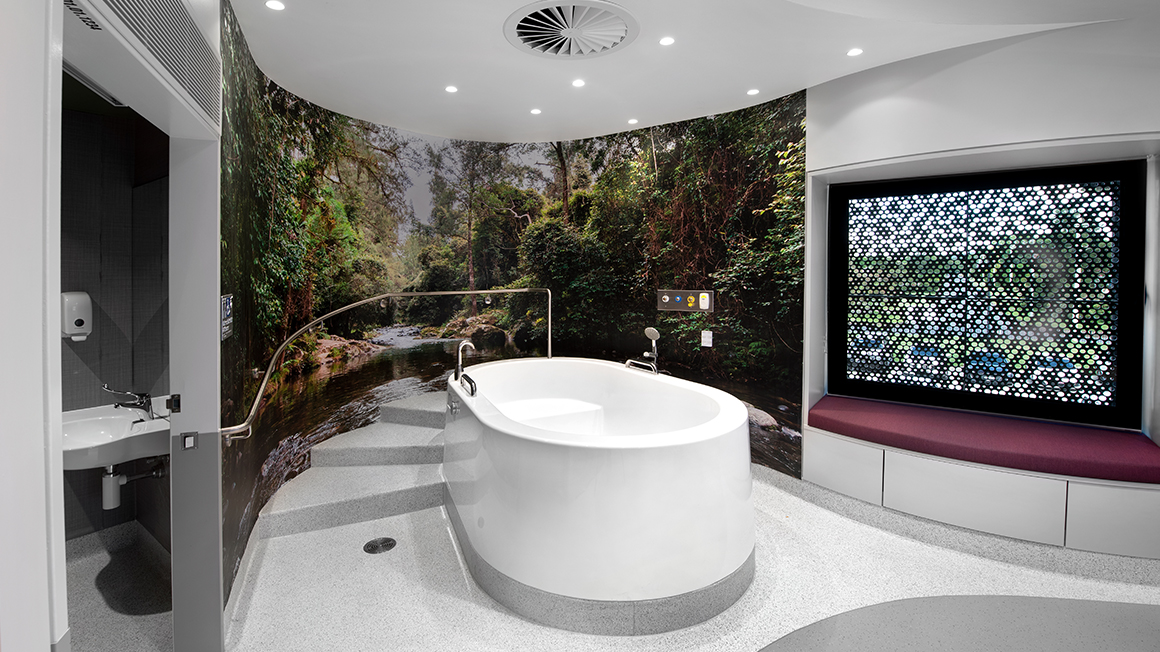
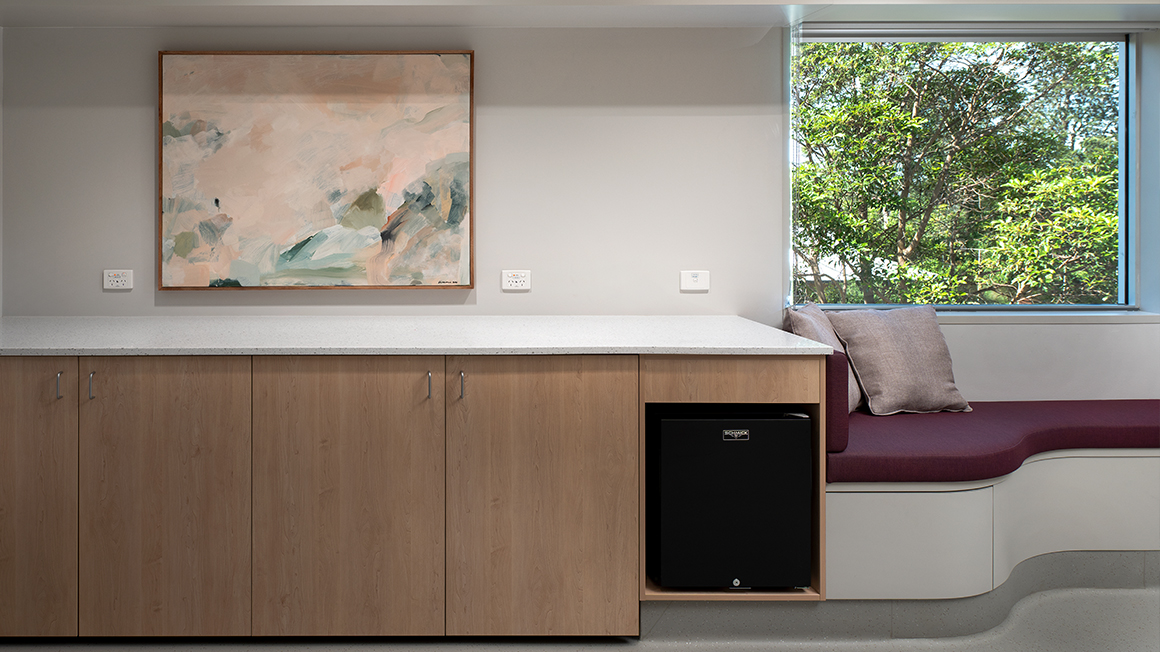
The most recent project at Singleton Hospital, two new birthing suites, was only made possible by the generous and altruism donation of the Bowman family. Allister Bowman Jnr and sibling Elizabeth Bowman. Both local residents, they have fond memories of visiting their grandfather Allister Bowman Snr, a doctor at the Hospital for over 50 years.
The existing birthing suites required upgrading to meet current health standards, function and expectations of both staff, mothers and their support carers. The previous birthing suites were cluttered, fear inducing, under sized, lacked privacy and shared an ensuite. Furthermore, there were no facilities for birth support person(s) and the suite itself was difficult for staff to move around. Due to these limiting factors, many expected mothers travelled to Muswellbrook, Maitland or sought private facilities. By improving the Birthing Facilities, it is anticipated the new suites and birthing baths will attract an increased number of women choosing to give birth locally close to family and friends.
The physiological significance of the birth environment was first championed by French obstetrician and childbirth specialist Michel Odent, who argued that the release of oxytocin, which underpins and drives labour and birth was highly dependent on environmental factors. Further Professor Maralyn Foureur, researcher and maternity care & midwifery clinician reports that the oxytocin system “..is key to approaching the creation of safe birth spaces since it is the agent behind all states of relaxation and wellbeing.” If the birth environment contributes to fear, the release of stress hormones and the fight or flight physiologic response felt in unsafe and unprotected spaces disrupted the progress of the mother’s labour, causing it to slow or stop.
Hunter New England Local Health District (HNELHD) undertook an Emotional Design Brief (EDB), based on knowledge from neuroscience, investigates the emotional experience of patients, support carers and staff of hospital environments. Rather than a clinical needs first design approach, the EDB identifies 4 key Emotional Design Domains and further ‘ideas for the future’, unique to Singleton Hospital, to improve the physical and psychologically experience of Health Architecture for patients, families, and staff. The Singleton Hospital Birthing Suites is the pilot project for the implementation of an Emotional Brief within HNELHD infrastructure projects.
A review of the evidence and interviews with women/partners who had recently given birth at Singleton Hospital and the staff of the unit, had identified a range of desirable attributes of the planned new birth rooms. What women and staff want in their birth environment, and what the evidence endorses, is a space that addresses the four domains of the BUDSET (Birth Unit Design Spatial Evaluation Tool). The four domains are described as the Fear Cascade; Aesthetics; Facility characteristics and Support characteristics.
The driving forces from the emotional brief is the development of an aesthetically pleasing, welcome, ambient at ‘home-like’ birthing space which is safe, secure, familiar, and an inclusive environment for the mother, support carer and midwifery staff. The space is comfortable, ‘designing out fear’ and instilling confidence to concentrate on the birth process with little to no intrusion from the outside. The ambient ‘at home-like’ environment does not recreate home but is a balance between the required functions of the medical facility and a calming, less medical atmosphere. On entering the birthing suites, the mother’s first experience is of a carefully selected artwork, a welcoming bench seat and a window with a view. Materials mimic natural textures, and the colours are deep, earthy, comfortable and soothing. Soft curving joinery and bulkheads suggesting warmth, well-being and harmony. The inclusion of nature either via views or artwork offer distraction and fosters well-being., while fear inducing medical equipment is hidden behind cupboards. The Mid-wife’s station is tucked in near the entry, allowing a non-intrusive presence while the reassurance of being close at hand.
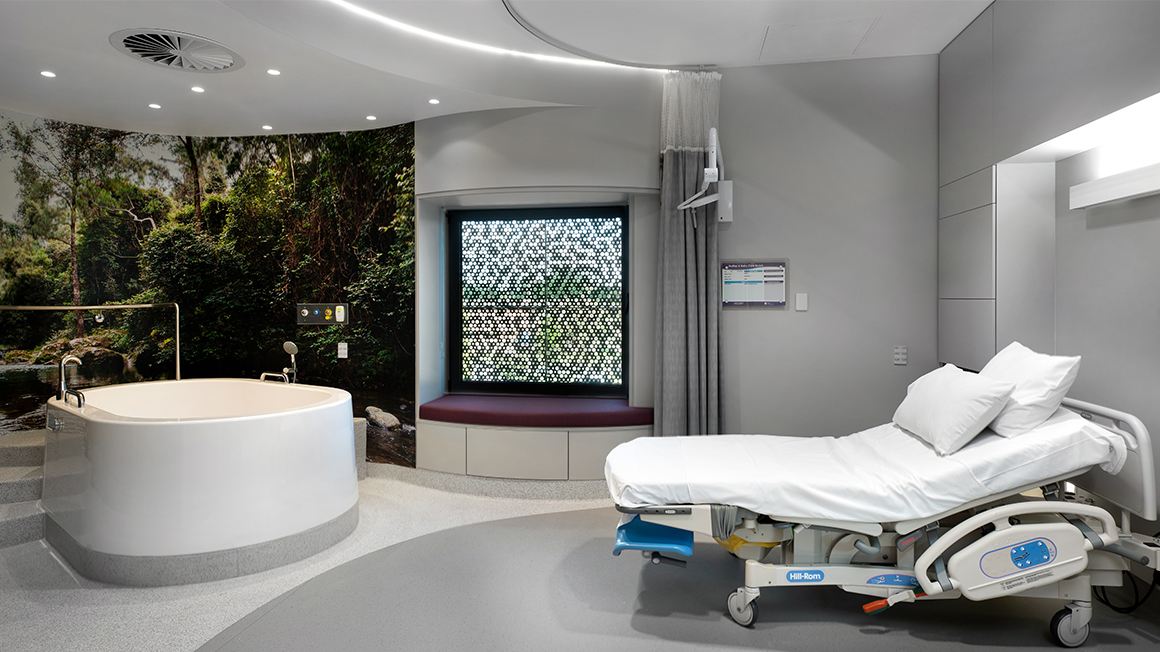
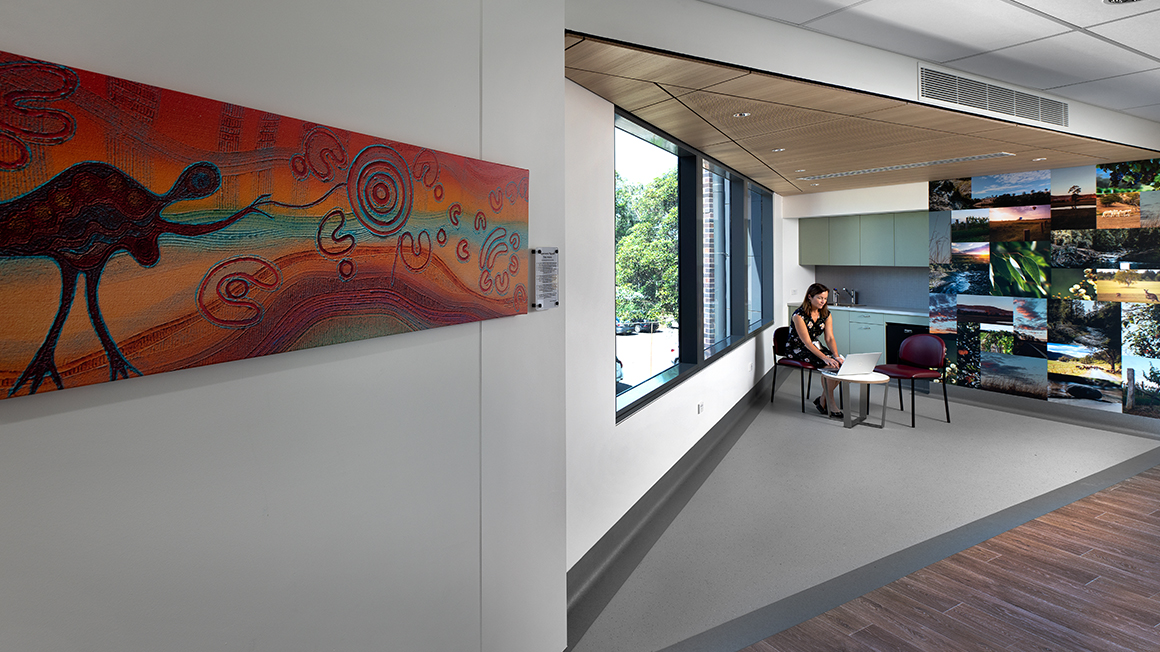
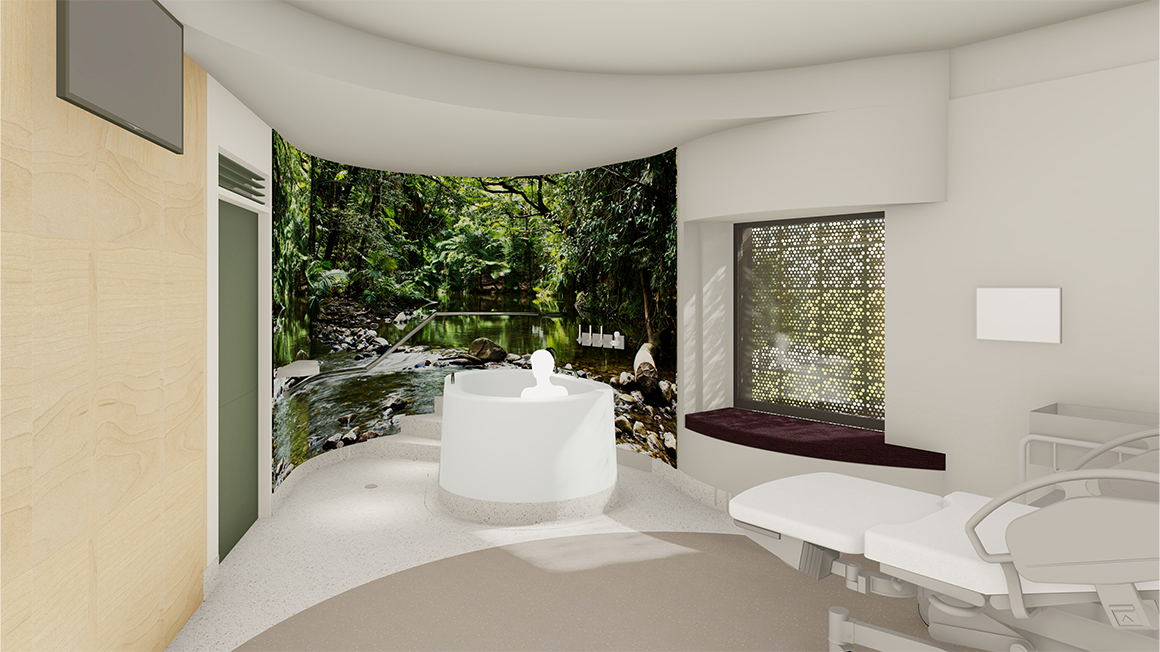
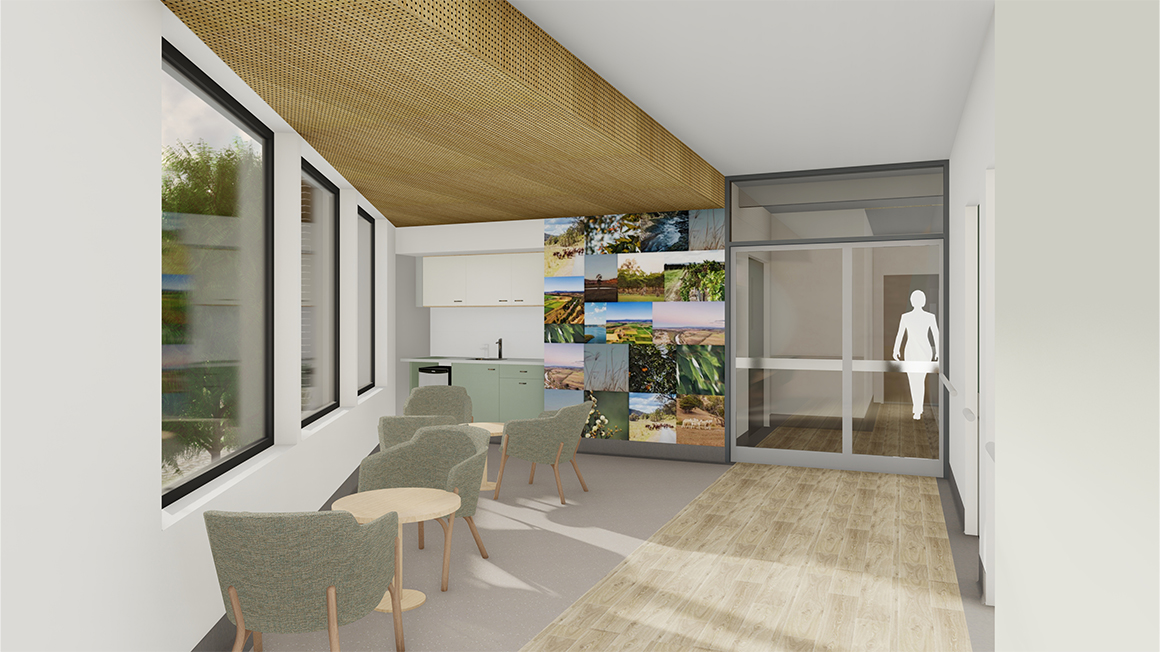
The driving forces from the emotional brief is the development of an aesthetically pleasing, welcome, ambient at ‘home-like’ birthing space which is safe, secure, familiar, and an inclusive environment for the mother, support carer and midwifery staff. The space is comfortable, ‘designing out fear’ and instilling confidence to concentrate on the birth process with little to no intrusion from the outside. The ambient ‘at home-like’ environment does not recreate home but is a balance between the required functions of the medical facility and a calming, less medical atmosphere. On entering the birthing suites, the mother’s first experience is of a carefully selected artwork, a welcoming bench seat and a window with a view. Materials mimic natural textures, and the colours are deep, earthy, comfortable and soothing. Soft curving joinery and bulkheads suggesting warmth, well-being and harmony. The inclusion of nature either via views or artwork offer distraction and fosters well-being., while fear inducing medical equipment is hidden behind cupboards. The Mid-wife’s station is tucked in near the entry, allowing a non-intrusive presence while the reassurance of being close at hand.
It is important for a mother to have control and choices over her birthing environment to fully ‘relax’ into the cycle of labour and create what is described as a ‘birth territory’, or ‘inner sanctum’. Several simple and practical measures are featured in the suites including dedicated storage, independent access to amenities such as tea & coffee making, ability to personalise the space, access to music and TV, various sources of dimmable lighting with multiple switches and temperature control.
An inclusive space is respectful and acknowledges the local cultural and spiritual traditions and their needs. Women, staff and families of the local indigenous group, the Wonnarua / Wanaruah people, were consulted through design workshops and their feedback including connection to country via local landscape artwork, aid in the healing process and reduce stress were included in the design of the space.
Creating privacy in a birthing suite, not just through the masterplan, includes acoustic and visual privacy. Ambient noise and being ‘looked upon’ can generate stress. The acoustically treated suites ensure mothers feel comfortable to make noise without fear of being overheard or overhear others. The layout ensures doors do not open directly into the active zone of the birthing suites. Windows allow natural light in but where required protect privacy using screens and blinds.
The last domain, support characteristics, ensures support carer(s) and midwifery staff are accommodated within the space. The room is large enough to accommodate several support carers and offers comfortable amenities including a beverage and food area, dedicated USB and power points, a bench seat to lie on, and a dedicated cupboard for personal items. Aesthetic features, design of equipment, room layout and fixtures all impacted on the midwifery staff and their practice. Research has identified four major practice themes: finding a space amongst congestion and clutter; working underwater; creating ambience in a medical environment and being equipped for flexible practice. Practical measures included in the space are adequate storage, numerous power points, a dedicated work area close to hand to the birthing mother, a seat, ease and quick access to medical equipment and safe practices around the bath particularly on the back and knees.
Within the birthing suites four inter-related functional spaces within the birthing suite were identified. The active zone, the bath, the ensuite and the bed. The active zone is spacious, open, flexible, offering the opportunity for a range of birthing equipment and positions, promoting mobility and active support carer involvement. Research has found that over one third (37%) of UK women rated access to a birth pool as ‘highly important’ and water (shower or bath) can assist in the release of oxytocin. The ensuite is a bounded space offering a sheltered, private, cocoon, womb-like spaces creating a sense of security and enclosure. As Britt Anderson (Australian Architect) stated ‘I think the very first sense of shelter you might have is actually being in your mother's arms. So it is that sometimes, you can make a space that is… comforting or protective in that way.’